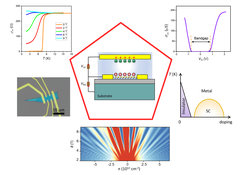Electrolyte Gating and Quantum Transport
Our group experimentally explores the electronic states of low-dimensional correlated materials, by investigating the transport properties of devices developed with micro-patterning and gating techniques. Correlated materials exhibit various electronic phases such as superconductivity, magnetism, non-trivial topological states, etc. stemming from the complex interactions between electrons. We aim to understand how the electron-electron interactions play a vital role in the correlated electron systems, and learn to control the quantum transport processes. Most of the systems we study are layered materials, including transition metal chalcogenides and delafossites, which typically display anisotropic transport characteristics.
Specifically, our interests lie in:
Exploration of new metals and superconductors with electrolyte gating
Electrolyte gated field-effect transistors have been exploited as powerful platforms to induce a plethora of exotic physical pheonema, enabled by the possibility to accumulate unprecedented charge carrier densities. We are interested in employing ionic liquid gated field-effect transistors to search for interface-based new metals and superconductors from otherwise intrinsic semiconductors and semi-metals. We also actively develop new gating methods that may help to probe the quantum processes.
Quantum transport in mesoscopic systems
At mesoscopic length scales, electrons behave as quantum mechanical wave-particles. The wave nature of electrons makes the laws of classical physics break down in the mesoscopic regime. We are interested in using state-of-the-art micro-patterning techniques (electron-beam lithography and focused ion beam) to structure the geometry of devices into the mesoscopic regime, and exploring the quantum transport behavior at low temperatures and high magnetic fields. In doing so, we seek to gain new levels of control and understanding on interacting states at mesoscopic length scales.

